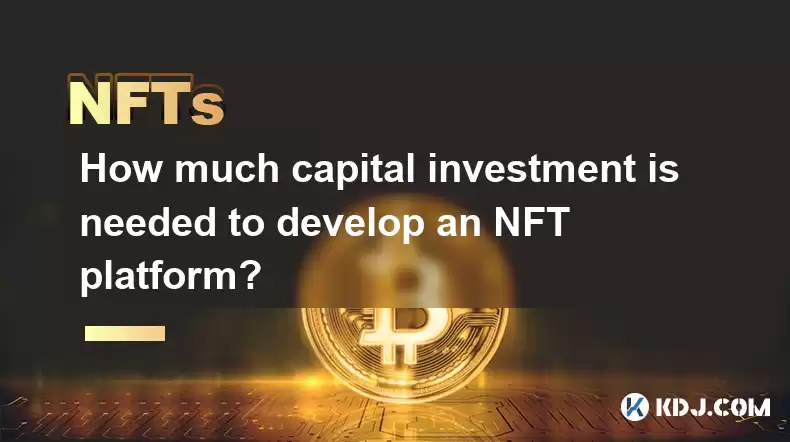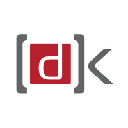-
 bitcoin
bitcoin $87959.907984 USD
1.34% -
 ethereum
ethereum $2920.497338 USD
3.04% -
 tether
tether $0.999775 USD
0.00% -
 xrp
xrp $2.237324 USD
8.12% -
 bnb
bnb $860.243768 USD
0.90% -
 solana
solana $138.089498 USD
5.43% -
 usd-coin
usd-coin $0.999807 USD
0.01% -
 tron
tron $0.272801 USD
-1.53% -
 dogecoin
dogecoin $0.150904 USD
2.96% -
 cardano
cardano $0.421635 USD
1.97% -
 hyperliquid
hyperliquid $32.152445 USD
2.23% -
 bitcoin-cash
bitcoin-cash $533.301069 USD
-1.94% -
 chainlink
chainlink $12.953417 USD
2.68% -
 unus-sed-leo
unus-sed-leo $9.535951 USD
0.73% -
 zcash
zcash $521.483386 USD
-2.87%
How much capital investment is needed to develop an NFT platform?
Developing an NFT platform can cost from $120,000 to $300,000, influenced by team expertise, tech stack, and marketing, with ongoing costs of $5,000 to $20,000 monthly.
Apr 18, 2025 at 08:00 am

Developing an NFT platform involves a variety of costs that can significantly impact the total capital investment required. The primary factors that influence the budget include the complexity of the platform, the technology stack used, the team's expertise, and the marketing strategy. In this article, we will explore these elements in detail to provide a comprehensive understanding of the investment needed to develop an NFT platform.
Understanding the Basics of NFT Platforms
Before delving into the costs, it's essential to understand what an NFT platform entails. NFT platforms are digital marketplaces that allow users to create, buy, and sell non-fungible tokens (NFTs). These tokens represent ownership of unique items or content, such as digital art, music, or collectibles. The development of such a platform requires a robust infrastructure to handle transactions, smart contracts, and user interactions.
Development Team and Expertise
The expertise and size of the development team are crucial factors in determining the cost of developing an NFT platform. A typical team might include:
- Blockchain Developers: Experts in blockchain technology and smart contract development.
- Frontend Developers: Responsible for creating the user interface and ensuring a smooth user experience.
- Backend Developers: Handle the server-side logic and database management.
- UI/UX Designers: Design the platform's look and feel to enhance user engagement.
- Project Managers: Oversee the project timeline and coordinate between different team members.
The cost of hiring these professionals can vary widely based on their experience and location. For instance, hiring a senior blockchain developer in the United States might cost between $150 to $250 per hour, whereas the same expertise in Eastern Europe or Asia could be $50 to $100 per hour. Assuming a team of five members working for six months, the total cost for the development team alone could range from $120,000 to $300,000.
Technology Stack and Infrastructure
The choice of technology stack and infrastructure also plays a significant role in the overall investment. Blockchain networks like Ethereum, Binance Smart Chain, or Flow are commonly used for NFT platforms. Each has its own set of costs associated with transaction fees, smart contract deployment, and network maintenance.
- Ethereum: Known for its robust ecosystem and high transaction fees, which can range from $10 to $100 per transaction.
- Binance Smart Chain: Offers lower transaction fees, typically around $0.10 to $0.50 per transaction, but may have less extensive smart contract capabilities.
- Flow: Designed specifically for NFTs and offers lower fees, around $0.00001 to $0.0001 per transaction, but may require more specialized development expertise.
Additionally, the platform will need servers, cloud services, and storage solutions to handle user data and transactions. Costs for these services can vary, but a basic setup might start at $500 to $1,000 per month, with more robust configurations costing upwards of $5,000 per month.
Smart Contract Development and Auditing
Smart contracts are the backbone of any NFT platform, enabling the creation, transfer, and management of NFTs. Developing these contracts requires specialized skills and can be time-consuming. The cost of smart contract development can range from $10,000 to $50,000, depending on the complexity and the number of features.
Furthermore, smart contract auditing is crucial to ensure the security and integrity of the platform. Hiring a reputable auditing firm can cost between $10,000 to $30,000. This step is essential to prevent vulnerabilities and potential hacks, which could lead to significant financial losses and damage to the platform's reputation.
User Interface and Experience
The user interface (UI) and user experience (UX) are critical for the success of an NFT platform. A well-designed UI/UX can attract and retain users, while a poor design can drive them away. The cost of UI/UX design can vary significantly, but a comprehensive design and development process might cost between $20,000 to $50,000.
This includes:
- Wireframing and Prototyping: Creating initial sketches and interactive prototypes to test user flows.
- Designing the UI: Crafting the visual elements, including colors, typography, and icons.
- Developing the Frontend: Implementing the design into a functional user interface.
- Usability Testing: Conducting tests with real users to gather feedback and make improvements.
Marketing and Launch Strategy
Once the platform is developed, a robust marketing strategy is necessary to attract users and creators. Marketing costs can vary widely depending on the target audience and the channels used. A typical marketing budget for an NFT platform might range from $50,000 to $200,000.
Key marketing activities include:
- Social Media Campaigns: Engaging with potential users on platforms like Twitter, Instagram, and Discord.
- Influencer Partnerships: Collaborating with influencers in the NFT and crypto space to promote the platform.
- Content Marketing: Creating blogs, videos, and guides to educate users about the platform and its benefits.
- Paid Advertising: Running ads on search engines, social media, and crypto-related websites.
Additionally, the launch strategy should include a beta testing phase to gather user feedback and make necessary adjustments before the official launch. This phase can cost an additional $10,000 to $20,000.
Legal and Compliance
Navigating the legal and compliance landscape is another critical aspect of developing an NFT platform. Legal fees can range from $5,000 to $20,000, depending on the jurisdiction and the complexity of the platform's operations.
Key legal considerations include:
- Regulatory Compliance: Ensuring the platform complies with local and international regulations regarding cryptocurrencies and digital assets.
- Intellectual Property: Protecting the platform's branding and any proprietary technology.
- User Agreements: Drafting terms of service, privacy policies, and other legal documents to protect the platform and its users.
Frequently Asked Questions
Q1: Can I develop an NFT platform with a smaller budget?A: Yes, it is possible to develop an NFT platform with a smaller budget by focusing on a minimal viable product (MVP) and using more cost-effective technology stacks. However, this may limit the platform's features and scalability.
Q2: How long does it typically take to develop an NFT platform?A: The development timeline can vary, but a typical project might take between six to twelve months, depending on the complexity and the team's size and expertise.
Q3: What are the ongoing costs after launching an NFT platform?A: Ongoing costs can include server maintenance, transaction fees, marketing, and customer support. These can range from $5,000 to $20,000 per month, depending on the platform's scale and activity.
Q4: Is it necessary to have a dedicated team for an NFT platform, or can I outsource development?A: While having a dedicated team can offer more control and customization, outsourcing development to specialized firms or freelancers can be a more cost-effective option. The choice depends on the project's specific needs and budget constraints.
Disclaimer:info@kdj.com
The information provided is not trading advice. kdj.com does not assume any responsibility for any investments made based on the information provided in this article. Cryptocurrencies are highly volatile and it is highly recommended that you invest with caution after thorough research!
If you believe that the content used on this website infringes your copyright, please contact us immediately (info@kdj.com) and we will delete it promptly.
- Ray Dalio's Portfolio Prescription: Why Bitcoin and Gold Are Essential in a Debt-Ridden World
- 2025-12-19 01:35:01
- Taiwan's Bitcoin Trove: Criminal Investigations Unearth a Surprising Global Ranking
- 2025-12-19 01:30:02
- Coinbase's Bold Leap: Stocks, Prediction Markets, and the Future of Trading
- 2025-12-19 01:35:01
- Kaito, Kickstarter, and the Post-TGE Crash: Navigating Crypto's Volatile Launch Landscape
- 2025-12-19 01:15:01
- Jito Foundation's Onshoring Signals a New Dawn for Solana and Crypto Regulation in the US
- 2025-12-19 01:25:01
- Cardano's Midnight Token (NIGHT) Shines Amidst Crypto Economy Evolution, Highlighting Privacy and Next-Gen Potential
- 2025-12-19 01:15:01
Related knowledge

What are 'music NFTs'? Can they really change how artists earn money?
Dec 13,2025 at 11:20pm
Definition and Core Mechanics1. Music NFTs are unique digital tokens representing ownership of audio files, albums, live recordings, or associated rig...

What is a 'soulbound token' (SBT)? Can it be sold or transferred like a normal NFT?
Dec 12,2025 at 02:19am
Definition and Core Characteristics1. A soulbound token (SBT) is a non-transferable digital credential issued to a specific blockchain address, design...

What does 'GMI' or 'WAGMI' mean in the NFT community? What are other common acronyms?
Dec 13,2025 at 03:19pm
Origins and Cultural Significance of GMI and WAGMI1. GMI stands for “Going to Make It”, a phrase that emerged from early crypto Twitter circles as a d...

What is an 'NFT aggregator' like Gem or Genie? How can it help me save on gas fees?
Dec 18,2025 at 02:20pm
Understanding NFT Aggregators1. An NFT aggregator is a platform that pulls real-time listing data from multiple NFT marketplaces—such as OpenSea, Blur...

What is 'paper handing' an NFT? Why do people say you should have 'diamond hands'?
Dec 18,2025 at 09:00am
Paper Hands Defined1. Paper hands refer to investors who sell their NFTs quickly after purchasing, often in response to minor price fluctuations or sh...

What is 'wash trading' in NFTs? How does it create fake volume and prices?
Dec 15,2025 at 06:19pm
Definition and Mechanics of Wash Trading1. Wash trading refers to the practice where a single entity or colluding parties buy and sell the same NFT re...

What are 'music NFTs'? Can they really change how artists earn money?
Dec 13,2025 at 11:20pm
Definition and Core Mechanics1. Music NFTs are unique digital tokens representing ownership of audio files, albums, live recordings, or associated rig...

What is a 'soulbound token' (SBT)? Can it be sold or transferred like a normal NFT?
Dec 12,2025 at 02:19am
Definition and Core Characteristics1. A soulbound token (SBT) is a non-transferable digital credential issued to a specific blockchain address, design...

What does 'GMI' or 'WAGMI' mean in the NFT community? What are other common acronyms?
Dec 13,2025 at 03:19pm
Origins and Cultural Significance of GMI and WAGMI1. GMI stands for “Going to Make It”, a phrase that emerged from early crypto Twitter circles as a d...

What is an 'NFT aggregator' like Gem or Genie? How can it help me save on gas fees?
Dec 18,2025 at 02:20pm
Understanding NFT Aggregators1. An NFT aggregator is a platform that pulls real-time listing data from multiple NFT marketplaces—such as OpenSea, Blur...

What is 'paper handing' an NFT? Why do people say you should have 'diamond hands'?
Dec 18,2025 at 09:00am
Paper Hands Defined1. Paper hands refer to investors who sell their NFTs quickly after purchasing, often in response to minor price fluctuations or sh...

What is 'wash trading' in NFTs? How does it create fake volume and prices?
Dec 15,2025 at 06:19pm
Definition and Mechanics of Wash Trading1. Wash trading refers to the practice where a single entity or colluding parties buy and sell the same NFT re...
See all articles









































































